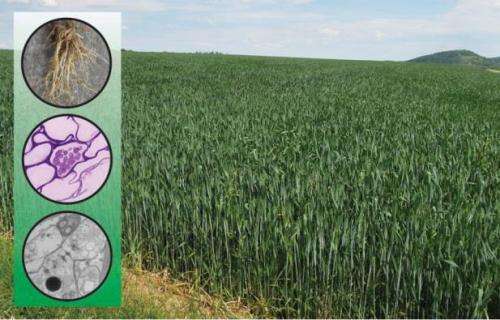Wheat growing in a field; top: roots cleared of soil; center and bottom: Serendipita herbamans under the microscope.
Researchers at the University of Tübingen have discovered a microscopic fungus which promotes growth in certain plants. "This fungus, native to Europe, is an organic fertilizer with the potential to increase yields of crops such as wheat and maize," says Sigisfredo Garnica of the Institute of Evolution and Ecology.
Dr. Garnica and Dr. Kai Riess discovered the Serendipita herbamans fungus in the roots of various plant species. Working with their colleagues at the Institute, Professor Franz Oberwinkler and Dr. Robert Bauer, they used molecular methods to establish that the tiny fungus was present in root cells. Vast numbers of fungi live in symbiosis with plants. Like animals, fungi cannot photosynthesize – they get all the products of photosynthesis from plants in the form of carbohydrates. In return, they are specialized in breaking down organic materials in the soil, releasing nutrients for their hosts to use. Only a few such symbiotic fungi are known to be cultivatable in the laboratory.
Serendipita herbamans grows well under lab conditions and has had a positive effect on root growth in thale cress, Arabidopsis thaliana, often used in laboratory testing. The researchers say crops infected with the fungus would likely show improved growth – it could work as a biological fertilizer.
Over the course of several years, the scientists investigated symbiotic Sebacinales fungi found in approximately one thousand herbaceous plants in fields and meadows. Serendipita herbamans – which means "herb-loving" – was found in 55 central European plant species. The scientists will now investigate whether the newly-discovered fungus lives up to expectations.
More information: Kai Riess, Franz Oberwinkler, Robert Bauer, Sigisfredo Garnica (2014): "Communities of endophytic Sebacinales associated with roots of herbaceous plants in agricultural and grassland ecosystems are dominated by Serendipita herbamans sp. nov." PLoS ONE 9(4): e94676. DOI: 10.1371/journal.pone.0094676
Journal information: PLoS ONE
Provided by Universitaet Tübingen






















